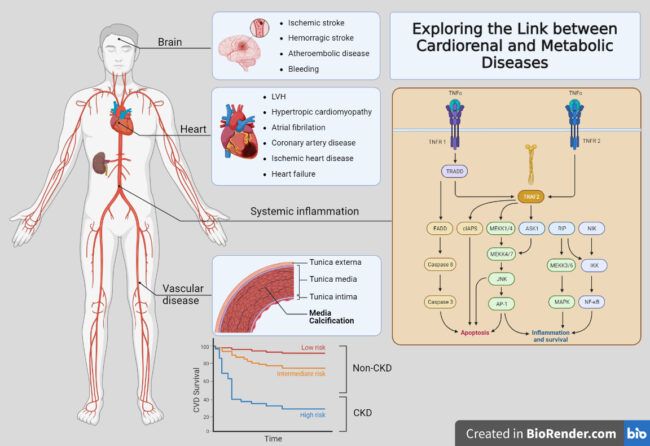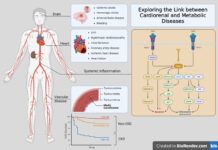Recently, investigators from Universidad Cardenal Herrera-CEU publised the final editorial from an Special Issue called “Exploring the Link between Cardiorenal and Metabolic Diseases” https://www.mdpi.com/journal/healthcare/special_issues/Y7RQZ8L7BH. Regarding this issue, we want to highlight some important aspects of these complex interactions.
The close link between metabolic diseases, such as obesity and diabetes mellitus, and cardiorenal disease can be attributed not only to direct risk factors, such as hypertension, but also to the intricate interplay of various pathophysiological processes. These metabolic conditions contribute to the development and progression of cardiorenal diseases through multiple mechanisms, including the activation of pro-inflammatory and pro-atherogenic pathways mediated by oxidative stress and inflammation (Figure). When examining this relationship, chronic kidney disease (CKD) itself can foster a pro-inflammatory state characterized by increased oxidative stress and insulin resistance. As CKD progresses, it disrupts normal metabolic processes, ultimately leading to an elevated risk of cardiovascular events and mortality. Thus, gaining a comprehensive understanding of the kidney–heart axis and its associated alterations becomes paramount in effectively managing and addressing the cardiorenal complications stemming from CKD. By delving deeper into the intricate connections between the kidney and heart, medical professionals can implement more accurate and proactive approaches to patient care.

Central to this pursuit is the identification of biomarkers capable of detecting preclinical stages of cardiorenal disease. Early detection can significantly improve patient outcomes, allowing for timely intervention and preventive measures to halt disease progression. By identifying specific biomarkers indicative of impending cardiorenal complications, healthcare providers can tailor treatments and strategies to the individual needs of each patient, thus enhancing the overall quality of care [4,5]. Additionally, a better comprehension of the kidney–heart axis opens doors to exploring novel therapeutic targets and interventions. Researchers can delve into innovative treatment modalities aimed at mitigating the impact of metabolic conditions on cardiorenal health.
An interdisciplinary approach involving nephrologists, cardiologists, endocrinologists, and researchers will facilitate the development of more effective and personalized treatment regimens. Accordingly, collaboration among medical professionals, academic institutions, and research centers becomes pivotal. Data sharing and joint efforts in conducting clinical studies will strengthen our understanding of these complex relationships. Moreover, fostering dialogue between various stakeholders will promote knowledge exchange, leading to innovative breakthroughs in the field.
Finally, the authors conclude that recognizing the intricate connections between metabolic diseases, cardiorenal health, and associated complications unveils a realm of possibilities for enhancing patient care. Through a multidisciplinary approach, focused research, and a commitment to improving early detection, we can stride towards better outcomes for those impacted by these conditions. Embracing the evolving landscape of the kidney–heart axis holds the key to unlocking advancements that will redefine the future of cardiorenal disease management.
You can scan this QR code to free access to the journal paper.











